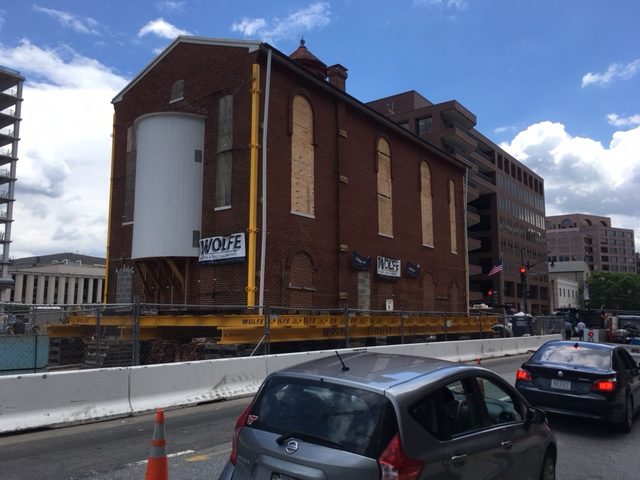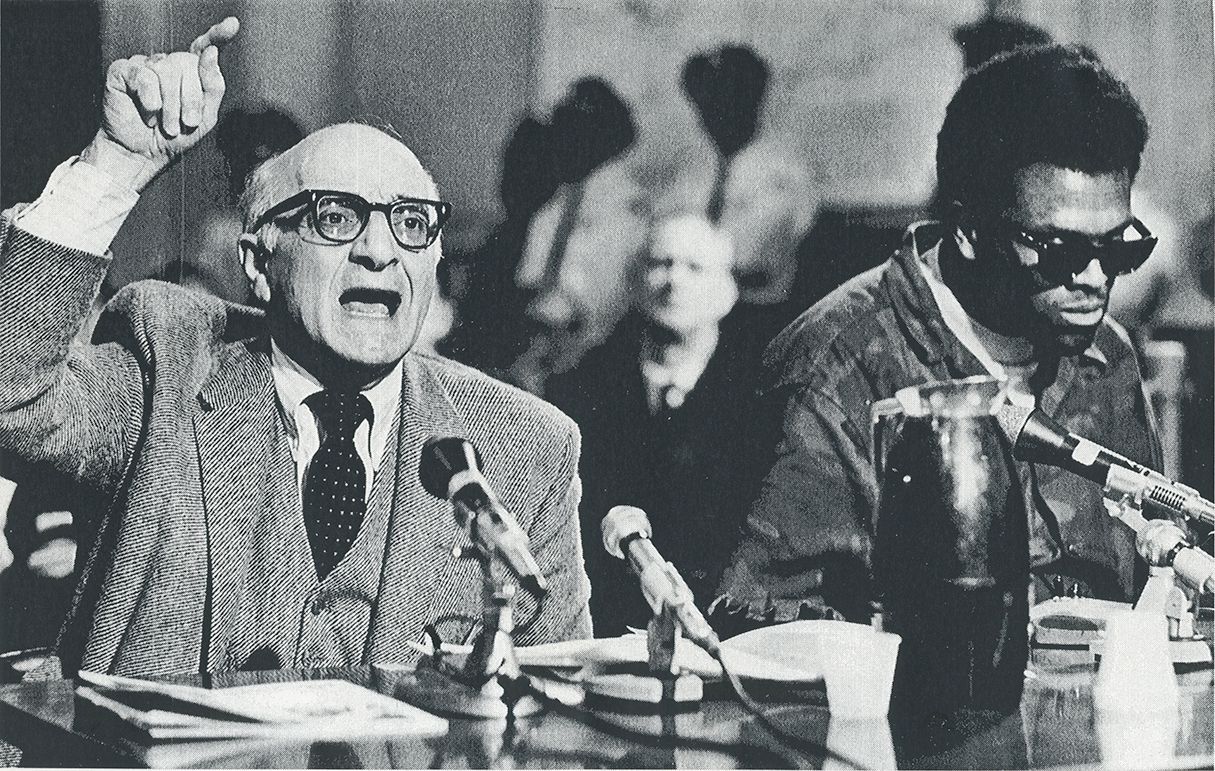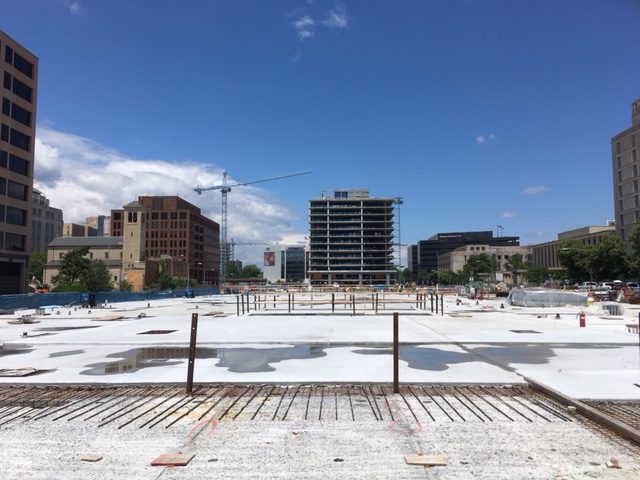In Part I, I didn’t note the most visible change in the old Urban League Neighborhood Development Program area – a gaping trench that holds I-395, emerging from its tunnel under the Mall, filling a vanished Second Street widened to the alleyway between Second and Third, then jogging slightly west under the Massachusetts Avenue overpass to wipe out Third Street before gradually rising to ground level at K Street NW and petering out into New York Avenue, NW.
For four decades, the I-395 trench scared the neighborhood, but you can’t see it today. So, great is the voracious hunger for developable land in Downtown Washington that the trench is now being decked over for the $1.5 billion Capitol Crossing development. Covering three square blocks of air rights above the freeway are rising four office buildings, totaling 1.9 million square feet, and one 150-unit condo building (including 50 units affordable to households at 80 percent of Area Median income), as well as five levels of underground parking and 70,000 square feet of retail space.
Not every building has been knocked down, however. Adas Israel, D.C.’s oldest synagogue will be moved (for the third time, first in 1969, second in 2016) from Third and G, NW about 1,000 feet to Third and F, NW, where it will become a museum of Jewish history and culture.

Adas Israel’s 273-ton red brick building has already been moved twice, both times to make room for new development. Photo by David Rusk.
However, the I-395 trench itself is a fossil–the extant remains of two gargantuan, planned interstate freeway systems within D.C. In 1956 federal highway planners proposed three loops around and through the city, totaling 329 miles of freeways.
- the 64-mile Capital Beltway (I-495) that was ultimately built;
- a middle beltway, beginning at East Capitol Street (at the site of the future Robert F. Kennedy Memorial Stadium), running northward through Anacostia Park, cutting northeast through the Trinidad neighborhood along Mt. Olivet Road NE, following the Amtrak rail line north to Missouri Avenue NW, along Missouri Avenue NW to Military Road NW, along Military Road NW across Rock Creek Park to Nebraska Avenue NW, down Nebraska Avenue NW to New Mexico Avenue NW, down New Mexico Avenue NW and across Glover-Archbold Park until it terminated near 37th Street NW at the north end of Georgetown (whose residents were too politically powerful to allow it to be continued into Georgetown); and
- an inner beltway which would be a flattened oval beginning at the future Kennedy Center/Watergate complex in the west, running southeast along what is currently Ohio Drive SW (skirting the Tidal Basin and the future Franklin Delano Roosevelt and Martin Luther King, Jr. memorials) until it linked with the Southwest Freeway portion of I-395) north along I-395 to L Street NW (The Mall tunnel and trench), and then west along a six-lane underground tunnel beneath K Street NW to join near the western nexus with the Whitehurst Freeway and I-66—completing the loop.
Linking all three loops would be a freeway extending I-95 inside the Capital Beltway through the District. The original plan would have brought the connecting link largely down the Connecticut Avenue, NW corridor, but wealthy, white neighbors in Cleveland Park (where many members of Congress also lived) successfully fought it.
In 1964 (my first year working for the Urban League) Congress authorized an alternative – the North-Central Freeway – that would come through predominantly white suburbs like Silver Spring and Takoma Park, then slash southward through Brookland and other majority black neighborhoods until it linked up with what is today’s I-395 at New York Avenue and L Street, NW. The wry view within civic activist circles was that the planners and politicians had kept pushing the north-south freeway eastward until its path would be through neighborhoods too poor and too black to resist it successfully.

Sammie Abbott and Reginald Booker. Photograph via DC Public Library/Washington Star, originally appeared on the Washingtonian.
Fighting the federal plan
The powers-that-be underestimated the people. Sammie Abbott (a white resident, and future Mayor, of Takoma Park) and Reginald Booker (a black activist whose family had already been forced out of their Southwest home by urban renewal) organized a racially and socioeconomically inclusive Emergency Committee on the Transportation Crisis (ECTC). They linked highway opposition to civil rights: “No white man’s roads through black man’s homes” was their cry. ECTC championed an alternative to the horrific highway plans: a subway system to allow city and suburban residents to travel within D.C. and surrounding suburbs.
ECTC members lobbied District officials and Congress, picketed, and protested in creative ways that caught media attention. They built alliances with other influential groups such as the mainly white Committee of 100 on the Federal City and the primarily black Federation of Civic Associations.
The alliance’s greatest victories came in courtrooms. In February 1968, the federal appeals court ruled that city officials had wrongfully ignored a city law from 1893 requiring public input on planned highways. After this ruling, the District created a new transportation plan that abandoned the old plans for the North-Central Freeway and the Three Sisters Bridge (north of Key Bridge), the most controversial aspects of the previous plan.
Despite this success, Congress still restricted the city from completely halting freeway construction. Members of Congress who supported the freeways tried to overturn the court decision by adding an amendment to the Federal Aid Highway Act of 1968 that required D.C. to complete the construction of the freeways and refused to appropriate funds for the subway until the city completed all freeways.
To secure subway funds, the District reversed itself, breathing new life into the North-Central Freeway and the Three Sisters Bridge. However, in April 1970 the court reaffirmed that District residents had a right to give input on the design and planning of the Three Sisters Bridge and halted all construction.
Subsequently, a majority of Congress overruled highway advocates that had held Metro funds hostage and, nationwide, authorized cities and states to use federal funding for mass transit in addition to highways. By 1977, all interstates within the District for which construction had not begun were wiped off the plans.
Despite all the influence of business groups, highway builders, and pro-highway local and federal officials, through interracial, cross-class collective action We the People had indeed Overcome. The way Interstates end abruptly in D.C. is witness to that. But some neighborhoods, including the future NoMa, paid the price of winning.
Creating a NoMa–indeed, an entire Nation’s Capital – that will be a model racially and economically inclusive community for the nation is a still-daunting task. The Millennial Generation driving D.C.’s population resurgence practices genuine and relaxed tolerance for all races, ethnic groups, and sexual orientations. Creating public policies that show the same inclusiveness towards all income groups will be our next challenge.
Previous: Once upon a time in NoMa
